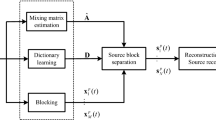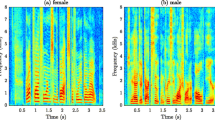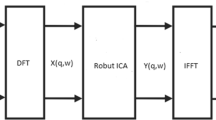Abstract
Underdetermined blind signal separation (BSS) (with fewer observed mixtures than sources) is discussed. A novel searching-and-averaging method in time domain (SAMTD) is proposed. It can solve a kind of problems that are very hard to solve by using sparse representation in frequency domain. Bypassing the disadvantages of traditional clustering (e.g., K-means or potential-function clustering), the durative-sparsity of a speech signal in time domain is used. To recover the mixing matrix, our method deletes those samples, which are not in the same or inverse direction of the basis vectors. To recover the sources, an improved geometric approach to overcomplete ICA (Independent Component Analysis) is presented. Several speech signal experiments demonstrate the good performance of the proposed method.
Similar content being viewed by others
References
Cardoso J-F. Blind signal separation: statistical principles. Proc IEEE (Special Issue on Blind Identification and Estimation), 1998, 90(10): 2009–2026
Cichocki A, Amari S. Adaptive Blind Signal and Image Processing: Learning Algorithms and Applications. New York: Wiley, 2002
Li Y, Wang J. Sequential blind extraction of instantaneously mixed sources. IEEE Trans Sign Proc, 2002, 50(5): 997–1006
Chen S, Donoho D L, Saunders M A. Atomic decomposition by basis pursuit. SIAM J Sci Comput, 1998, 20(1): 33–61
Olshausen B A, Sallee P, Lewicki M S. Learning sparse image codes using a wavelet pyramid architecture. In: Todd K L, Thomas G, Dietterich T, et al., eds. Advances in Neural Information Processing Systems 13. Boston: MIT Press, 2001. 887–893
Lee T-W, Lewicki M, Girolami M, et al. Blind source separation of more sources than mixtures using overcomplete representations. IEEE Sign Proc Lett, 1999, 6(4): 187–190
Zibulevsky M, Pearlmutter B A. Blind source separation by sparse decomposition in signal dictionary. Neur Comput, 2001, 13(4): 863–882
Li Y, Andrzej C, Amari S. Analysis of sparse representation and blind source separation. Neur Comput, 2004, 16(6): 1193–1234
Bofill P, Zibulevsky M. Underdetermined blind source separation using sparse representations. Sign Proc, 2001, 81(11): 2353–2362
Bofill P. Underdetermined blind separation of delayed sound sources in the frequency domain. Neurocomput, 2003, 55(3): 627–644
Theis F J, Lang W E, Puntonet C G. A geometric algorithm for overcomplete linear ICA. Neurocomput, 2004, 56: 381–398
Author information
Authors and Affiliations
Corresponding author
Additional information
Supported by the National Natural Science Foundation of China (Grant Nos. U0635001, 60505005 and 60674033), the Natural Science Fund of Guangdong Province (Grant Nos. 04205783 and 05006508), and the Specialized Prophasic Basic Research Projects of the Ministry of Science and Technology of China (Grant No. 2005CCA04100)
Rights and permissions
About this article
Cite this article
Xiao, M., Xie, S. & Fu, Y. Searching-and-averaging method of underdetermined blind speech signal separation in time domain. SCI CHINA SER F 50, 771–782 (2007). https://doi.org/10.1007/s11432-007-0066-x
Received:
Accepted:
Issue Date:
DOI: https://doi.org/10.1007/s11432-007-0066-x




